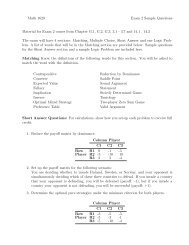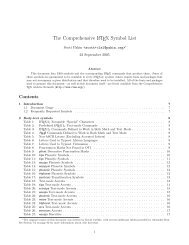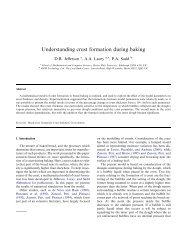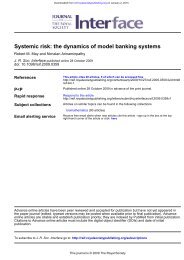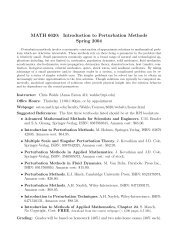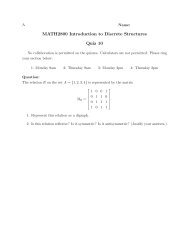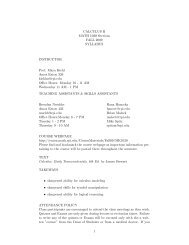On converging shock waves of spherical and polyhedral form
On converging shock waves of spherical and polyhedral form
On converging shock waves of spherical and polyhedral form
Create successful ePaper yourself
Turn your PDF publications into a flip-book with our unique Google optimized e-Paper software.
370 D. W. Schwendeman<br />
(a) (b) (c)<br />
C<br />
E<br />
P<br />
Q<br />
V<br />
R<br />
(d)<br />
(e)<br />
S<br />
T<br />
Figure 4. Top view <strong>of</strong> the successive <strong>shock</strong> surfaces in a <strong>converging</strong> channel corresponding to the<br />
construction in the cut planes shown in figure 3. (The contraction in scale is not shown in the<br />
figure.) The arrows indicate the direction <strong>of</strong> propagation <strong>of</strong> the <strong>shock</strong>-<strong>shock</strong>s.<br />
U<br />
the <strong>shock</strong> surface shown in figure 4(c) results. This configuration would correspond<br />
to the <strong>form</strong>ation <strong>of</strong> a dodecahedron as described in figure 1 for the case when the<br />
convergence angle φ is 37.38 ◦ , or to regular polyhedra with 6 or 4 faces when φ<br />
equals 54.74 ◦ or 70.53 ◦ , respectively.<br />
The condition for the incident <strong>shock</strong> to vanish at the point P shown in figure 4(c)<br />
can be worked out from the geometry <strong>of</strong> the <strong>shock</strong>-<strong>shock</strong> paths in figure 3 <strong>and</strong> (2.4)<br />
<strong>and</strong> (2.5) for the angles χ <strong>and</strong> ξ. The distance |OQ| in figure 3 can be determined in two<br />
ways. Let R 1 <strong>and</strong> R 2 denote the distance |OQ| according to the geometry in the planes<br />
OCE <strong>and</strong> OEV , respectively. A straightforward application <strong>of</strong> trigonometry gives<br />
(<br />
R 1 =<br />
tan χ<br />
tan θ + tan χ<br />
)<br />
|OE|, R 2 =<br />
( sec 2 ψ tan ξ<br />
tan ψ + tan ξ<br />
)<br />
|OE|.<br />
The values <strong>of</strong> R 1 <strong>and</strong> R 2 must be equal for the configuration in figure 4(c) to occur.<br />
The <strong>shock</strong>-<strong>shock</strong> <strong>form</strong>ulas (2.4) <strong>and</strong> (2.5) give the angles χ <strong>and</strong> ξ implicitly in terms<br />
<strong>of</strong> θ <strong>and</strong> ψ, respectively, <strong>and</strong> in terms <strong>of</strong> the exponent n in the area–Mach number<br />
relation (2.3). The angles θ <strong>and</strong> ψ, in turn, are related to φ by the geometric <strong>form</strong>ula<br />
(2.1) so that the ratio R 1 /R 2 depends on φ <strong>and</strong> n alone. In figure 5, we plot the ratio<br />
R 1 /R 2 as a function <strong>of</strong> φ for integer values <strong>of</strong> n between 1 <strong>and</strong> 7. As may be seen<br />
from the curves, there is a unique value <strong>of</strong> φ for a given value <strong>of</strong> n for which the ratio<br />
is 1 <strong>and</strong> the configuration in figure 4(c) occurs. The values <strong>of</strong> φ with R 1 /R 2 = 1 range<br />
between 0 as n → 0 <strong>and</strong> 70.53 ◦ as n → ∞. The collapse <strong>of</strong> a strong <strong>shock</strong> in the shape<br />
<strong>of</strong> an icosahedron initially to a dodecahedron corresponds to the case φ = 37.38 ◦ <strong>and</strong><br />
would occur when n = 1.185, <strong>and</strong> the collapse <strong>of</strong> a strong <strong>shock</strong> in the shape <strong>of</strong> an<br />
octahedron initially to a hexahedron corresponds to the case φ = 54.74 ◦ <strong>and</strong> would<br />
occur when n = 4.269. The limiting value <strong>of</strong> φ = 70.53 ◦ (n → ∞) corresponds to the<br />
collapse <strong>of</strong> a strong <strong>shock</strong> in the shape <strong>of</strong> a regular tetrahedron initially.



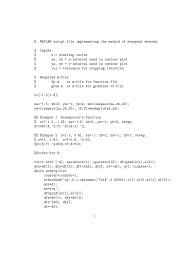

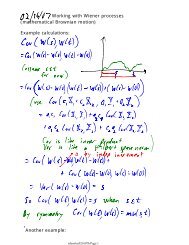

![MATH 1500 Sample Questions Exam 2 1. [3.7] A 10-ft plank is ...](https://img.yumpu.com/43861920/1/190x245/math-1500-sample-questions-exam-2-1-37-a-10-ft-plank-is-.jpg?quality=85)
